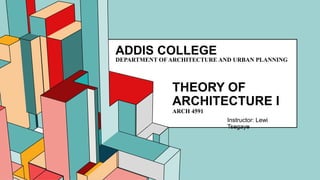
Chicago School & Prairie School
- 1. 6.53 THEORY OF ARCHITECTURE I ARCH 4591 Instructor: Lewi Tsegaye ADDIS COLLEGE DEPARTMENT OF ARCHITECTURE AND URBAN PLANNING
- 2. CONTENT 2 Chicago School Origin of Chicago School Architectural style Characteristics Architects Examples Prairie School Origin of Prairie School Architectural style Characteristics Architects Examples
- 3. CHICAGO SCHOOL ARCHITECTURAL STYLE 3
- 4. ORIGIN OF CHICAGO SCHOOL ARCHITECTURAL STYLE • Chicago School was a school of architects active in Chicago in the late 19th, and at the turn of the 20th century. • It is also known as Commercial Style and American Renaissance Style. • Louis Henry Sullivan was the most influential architect of the Chicago School. 18/4/2022 Pitch deck title 4 The Chicago Building by Holabird & Roche (1904–1905)
- 5. ORIGIN OF CHICAGO SCHOOL ARCHITECTURAL STYLE • Was among the first to promote the new technologies of steel-frame construction in commercial buildings. • Influenced, parallel developments in European Modernism. • In the 1940s, a "Second Chicago School" emerged from the work of Ludwig Mies van der Rohe who was a German-American architect. 18/4/2022 Pitch deck title 5
- 6. CHARACTERISTICS • Steel-frame buildings with masonry cladding (usually terra cotta). • Building exterior (envelope) is light weight compared to the previous buildings with load bearing masonry walls. 18/4/2022 Pitch deck title 6
- 7. CHARACTERISTICS • Large plate-glass (sheet glass) window areas. • It is a three-part window consisting of a large fixed center panel flanked by two smaller double-hung sash windows. This window is referred as "Chicago window“. 7
- 8. CHARACTERISTICS • Window arrangement on the facade creates a grid pattern, with some projecting out from the facade forming bay windows. • The Chicago window combined the functions of light-gathering and natural ventilation; a single central pane was usually fixed, while the two surrounding panes were operable. 8
- 9. CHARACTERISTICS • Like a classical column, the buildings have a base of two or three stories, a shaft arranged in vertical bands of mid-stories, and a cornice of several top stories. 18/4/2022 Pitch deck title 9 Mills Building, San Francisco Pacific Building, San Francisco Classical column
- 10. ARCHITECTS OF CHICAGO SCHOOL STYLE 18/4/2022 Pitch deck title 10 Louis Sullivan Dankmar Adler Guaranty Bldg. Wainwright Bldg. Reliance Bldg. John Wellborn Root Daniel Hudson Burnham 770 Broadway
- 11. EXAMPLES OF CHICAGO SCHOOL STYLE 18/4/2022 Pitch deck title 11 Sullivan Center, Chicago, Illinois, built 1899, Louis Sullivan Reliance Bldg, Chicago, Illinois 1889, John Wellborn Root
- 12. PRAIRIE ARCHITECTURAL STYLE Early 1890S – Late 1910S 12
- 13. ORIGIN OF PRAIRIE ARCHITECTURAL STYLE • The Prairie style emerged in semi-rural village on the Western edges of Chicago in the early 1890s from the work of a group of young architects, including Frank Lloyd Wright. • The Prairie School developed in symphony with the ideals and design aesthetics of the Arts and Crafts Movement begun in the late 19th century in England by John Ruskin, William Morris, and others. 18/4/2022 Pitch deck title 13 Frank Lloyd Wright (June 8, 1867 – April 9, 1959)
- 14. ORIGIN OF PRAIRIE ARCHITECTURAL STYLE • The title Prairie is due to the dominant horizontality of most Prairie style buildings, which resembles the wide, flat, treeless expanses of the mid-Western US. 18/4/2022 Pitch deck title 14
- 15. ORIGIN OF PRAIRIE ARCHITECTURAL STYLE • The Prairie School was an attempt at developing an indigenous North American style of architecture that did not share design elements and aesthetic vocabulary with earlier styles of European classical architecture. • The primary ideology of which was that a building’s form should grow out of its particular environment to exist in harmony with nature. 18/4/2022 Pitch deck title 15
- 16. CHARACTERISTICS • Characterized by dramatic horizontal lines and masses, Prairie buildings evoke the expansive Midwestern landscape. • The buildings reflect an all- encompassing philosophy that Wright termed “Organic Architecture.” • No tall buildings • Residences and banks 18/4/2022 16
- 17. EXAMPLES OF PRAIRIE SCHOOL STYLE 18/4/2022 Pitch deck title 17 The Darwin Martin House, New York,1905, FL Wright Robie House, Chicago, Illinois, 1908, FL Wright
- 18. ORGANIC ARCHITECTURE • Organic architecture is a philosophy of architecture which promotes harmony between human habitation and the natural world. • This is achieved through design approaches that aim to be sympathetic and well- integrated with a site, so buildings, furnishings, and surroundings become part of a unified, interrelated composition. 18/4/2022 18
- 19. THANK YOU